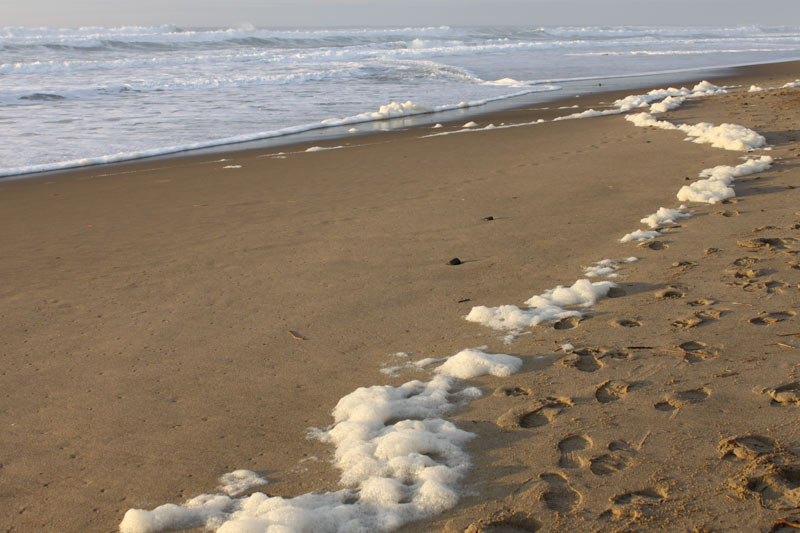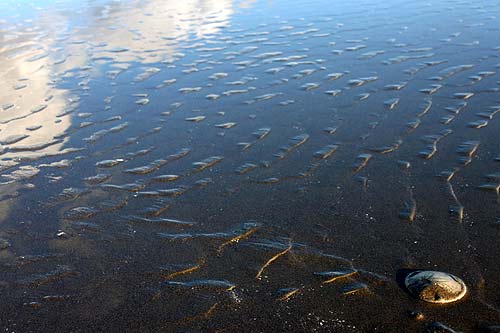The Basics and the Weird About Oregon Coast Sea Foam
Published 09/11/2019 at 11:33 PM PDT
By Oregon Coast Beach Connection staff

Includes exclusive listings; some specials in winter
In Cannon Beach:
Includes rentals not listed anywhere else
In Manzanita, Wheeler, Rockaway Beach:
Some specials for winter
In Pacific City, Oceanside:
Some specials for winter
In Lincoln City:
Some specials for winter
In Depoe Bay, Gleneden Beach:
Some specials for winter
In Newport:
Look for some specials
In Waldport
Some specials for winter
In Yachats, Florence
Some specials for winter
(Oregon Coast) – Sea foam along the Oregon coast is still a mystery to many people – and it somehow creates the wrong impression. Those white blobs of bubbles, drifting along the surfline or gliding in on the waves, somehow get mistaken for pollution, or something else bad.
In fact, those brilliant suds are a really good thing, the sign of a healthy ocean. They make for gorgeous photos and accentuate the movement of the waves, and they appear in varying degrees on these beaches.
It’s a natural process with a lot of surprises. The fact it is natural is one of the first surprises. Here’s the truth about sea foam and some startling factoids.
What Is It? Perhaps the most astounding fact about sea foam is what it really is. Essentially, the ocean is like a gigantic tumbler, churning up the sea so much it creates bubbles. It’s not unlike when you’re stirring your coffee really fast or some other liquid, it then makes air bubbles. The root of it all is friction. But there’s an even greater factor behind the existence of the white, blob-like stuff.
The biggest source of the air bubbles – and the friction – is an unbelievably large number of tiny skeletons of phytoplankton. The remains of these tiny one-celled organisms add much more viscosity in sea water, thus creating more air bubbles. There are so many you get vast globs of white and air bubbles. It’s one reason sea water stains your clothes.
Keep in mind it’s the skeletons of the dead phytoplankton – that’s not even counting the effect the live ones have. Phytoplankton – in case you’ve forgotten your high school science – are the bottom of the food chain, the microscopic things gobbled up by all kinds of ocean-dwelling things. Even whales.
Storms make for bigger winds and oceans that churn more heavily, so you get more sea foam. But if there’s an especially big bloom of the teeny, tiny plants, it can add to the presence of sea foam exponentially.

Weird Brown Foam. There are different kinds of phytoplankton along the Oregon coast: two of the most common are diatoms and dinoflagellates. Out of those two main branches, there are many different kinds along the coastline. Scientists don’t actually know how many species of diatoms and dinoflagellates there are.
Some kinds of diatoms make for brown foam, although this mostly happens up north around Seaside and Warrenton. It does on occasion get seen around Cannon Beach and even Manzanita. Periodically it's so intense it looks like brown sludge or something oily. It can be a simple brown coloring to the waves or it can be more spectacular, even looking chunky. When this happens it can alarm visitors; thinking it’s a bad spill, they’ll inquire to local businesses around Seaside. Or at least they used to, until the Seaside Aquarium and the city put up signs everywhere explaining it.
This brown waves phenomenon is also a sign of a very healthy ocean, according to Seaside Aquarium. It means all the nitrates and other nutrients that feed these little guys are flowing in great abundance, in turn creating massive blooms of the brown diatoms.
The area from Seaside to Warrenton is unique in this: nowhere else on the Oregon coast does this happen quite as much or as intensely. It largely has to do with the nutrients coming down from the Columbia River to this area.

Whole Sand Dollars and Clams. Clatsop Beach – from Seaside to Warrenton – has the highest density of razor clams in all of Oregon. 90 percent of the population of razor clams live here. Also unique here: the parts of Seaside and Gearhart surrounding the Necanicum River contain probably the largest amount of whole sand dollars you’ll find along the entirety of the coast.
The reason for both is that pairing of nutrients and extra phytoplankton populations. Clams and sand dollars live here in greater abundance because of all the stuff that feeds them (although exactly why so many sand dollar beds are just offshore in just this area is still a mystery to scientists).
When Waves and Sand Glow. One of the most dramatic and startling sights on the Oregon coast can be the phenomenon nicknamed “glowing sand.” Even the waves can have little brief, glowing sparks, although that’s rarer. If you’re walking on a beach at night under the right conditions, you may see tiny greenish/blue sparks beneath, around the wet sand by the tideline.
Find a beach with no light interference (Seaside is not good for this, except at the very northern edge), head to the wet sand and move your feet backwards. The tiny sparks can be exceptionally faint, so look close. Even more amazing is if you find pools of water just up the beach that have been around awhile, stomp your foot in there and you could see an entire galaxy explode beneath your feet.
All this comes from phytoplankton too – a form of the tiny critters called dinoflagellates (or at least one kind of them, anyway). They are bioluminescent, which means they glow when touched, like fireflies. Except these are exceptionally small. Oregon Coast Hotels for this event - Where to eat - Map - Virtual Tour
Cannon Beach Lodging
Nehalem Bay Lodgings
Manzanita Hotels, Lodging
Three Capes Lodging
Pacific City Hotels, Lodging
Lincoln City Lodging
Depoe Bay Lodging
Newport Lodging
Waldport Lodging
Yachats Lodging
Oregon Coast Vacation Rentals
Oregon Coast Lodging Specials
More About Oregon Coast hotels, lodging.....
More About Oregon Coast Restaurants, Dining.....
LATEST Related Oregon Coast Articles
Through 2 a.m. likely best, but some lights possible through dawn June 1 - 2. Space weather, astronomy
Rare Sperm Whale Stranding on N. Oregon Coast, Was Hit by Boat
Showing up near Gearhart, it will decompose naturally. Marine sciences
Coast Guard Barque 'America's Tall Ship' Coming to Portland Rose Fest, N. Ore...
Portland events: June 5 - 8; Astoria events June 13 - 15. Weather
Bright and Active Arietids Meteors May Hit Pre-Dawn Hours of Oregon, Washingt...
Look to east hour before sunrise and you may catch a show. Sciences, astronomy, weather
Why Now Could Be a Great Week for Spotting Killer Whales on Oregon Coast - Video
A good dozen documentations around Depoe Bay, Newport, Coos Bay, Bandon, Tillamook. Marine sciences
Summer Road Work, Traffic Issues Along Oregon Coast Include Astoria, Garibald...
Some daylight closures include bridges, OR 22, OR 18, OR 26, more. Travel tips. Seaside, Cannon Beach, Lincoln City. Travel tips
Pacific City Oregon Weather, 7-Day Forecasts, Live Conditions, Radar, Webcams...
Updated Constantly: Pacific City, Tierra Del Mar, Oregon Weather, Cams, Buoy Observations, Tides, Warnings - Alerts
Oregon Coast Has World's Oldest Harbor Seal, Celebrating 50 Years Soon
June 3 at Oregon Coast Aquarium in Newport. Newport events
Back to Oregon Coast
Contact Advertise on BeachConnection.net
All Content, unless otherwise attributed, copyright BeachConnection.net Unauthorized use or publication is not permitted





















































